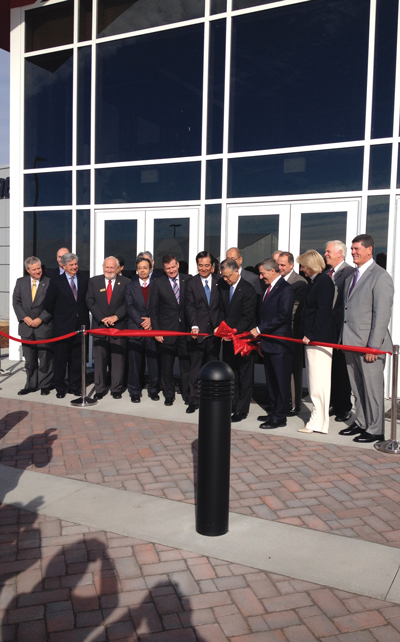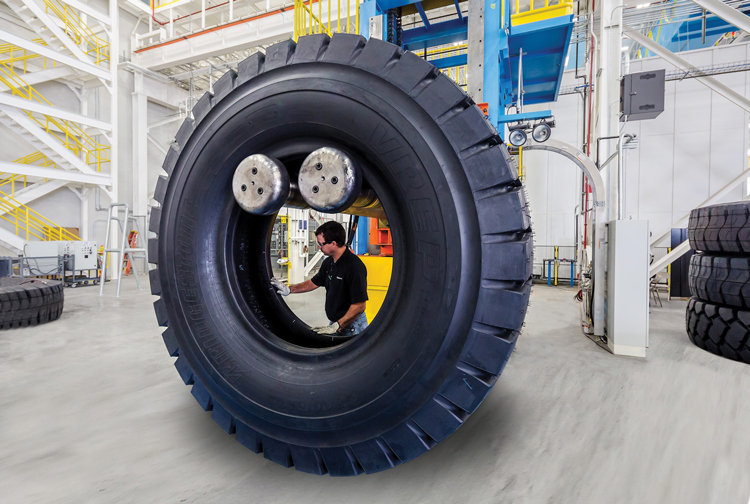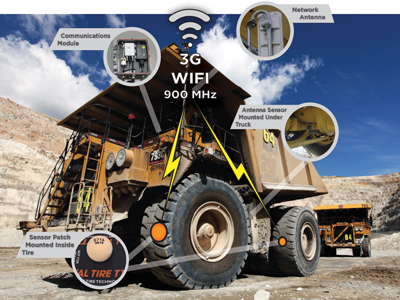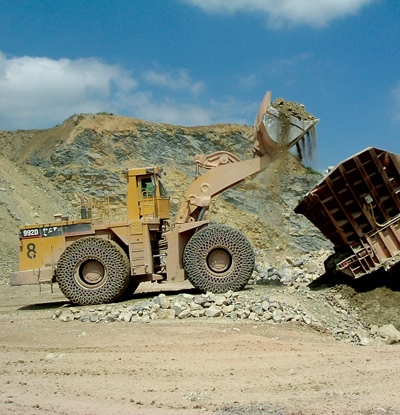Bridgestone opens first U.S. mining tire manufacturing facility
By Steve Fiscor, Editor-in-Chief

About 400 people gathered to celebrate the grand opening of Bridgestone’s newest mining tire plant.
Extending its leadership in the heavy-duty, earthmoving tire segment, Bridgestone Americas opened its first giant off-road radial tire plant during November. Based in Aiken County, South Carolina, the 1.5-million-ft2 manufacturing facility produces various off-road radial tires for mining equipment, including ultra-class haul trucks. The new plant strengthens Bridgestone’s ability to meet global demand for mining tires now and in the future.
About 400 people, including several mining executives, gathered to commemorate the grand opening. Aiken County Plant Manager Ron Brooks emceed the ceremony, which included speeches from Kazuhisa Nishigai, COO, Bridgestone Corp., and Gary Garfield, president and CEO of Bridgestone Americas, along with other Bridgestone executives and regional dignitaries.
“Bridgestone has made significant investments in technology and training to ensure we are producing the world’s leading off-road radial tires for the mining business in North America,” said Nishigai. “We remain highly committed to our mining customers around the globe and will continue to make the right investments for this important segment of our business.”
This is a first; previously all of Bridgestone’s large mining class tires were manufactured in Japan. In 2011, the company announced a planned $970 million investment to build the company’s first U.S.-based off-road radial tire plant, as well as expand production capacity at Bridgestone’s steel cord manufacturing facilities in Clarksville, Tennessee, and Saga, Japan.
The opening of the Aiken County Off Road Radial Tire Plant completes the largest portion of this planned investment.
“Engineering large and ultra-large mining tires is a highly technical process, and Bridgestone has a long tradition of being a leader in bringing these tires to market. The opening of a new off-road radial tire plant in South Carolina is a strategic business decision that will give us the capacity to build these tires domestically and improve our supply systems globally,” Garfield said. “Long term, the mining segment will grow, and we are now better-positioned to respond more quickly, efficiently and reliably to the needs of our customers.”
Bridgestone’s Off Road Radial Tire Plant is the second tire manufacturing plant Bridgestone has built in Aiken County, South Carolina. The company also operates a passenger tire facility located nearby. “Aiken County is a special place for Bridgestone and we’re delighted to see the company’s newest chapter unfolding here,” Brooks said. As he was introducing Nishigai, Brooks explained that it takes great leadership with strategic vision to make the right investments at the right time.
“The new Aiken plant will contribute significantly to our global business and to maintain our status as the leading tire supplier for the mining business,” Nishigai said. “Producing tires is a highly technical business and none is more difficult to produce than mining-class off-road radial tires. We have made a significant investment in technology to ensure that we are producing the world’s leading off-road mining tires here at the Aiken County facility. We expect the Aiken plant to make a very important contribution to customer satisfaction.”
Nishigai also explained that being the leader in this industry, also means being a leader as far as safety, sustainability, and protecting and preserving the environment. “This new facility features our biggest commitment to the tire manufacturing process in a sustainable, environmentally conscience manner,” Nishigai said. “As an example, the plant uses solar panels to improve lighting and reduce costs. Water conservation was a primary consideration in the plant’s overall design. We plan to recycle nearly all of the plant’s waste.”
Expressing his gratitude for the support Bridgestone has received in the U.S., Nishigai said, “Now is the time to meet the new challenge for the mining business and let’s do this together.”
A MAJOR INVESTMENT FOR THE AMERICAS
 Bridgestone COO Kazuhisa Nishigai cuts the ribbon. Gary Garfield, president and CEO, Bridgestone Americas, stands to his left. Ron Brooks, plant manager (far right) hosted the event.
Bridgestone COO Kazuhisa Nishigai cuts the ribbon. Gary Garfield, president and CEO, Bridgestone Americas, stands to his left. Ron Brooks, plant manager (far right) hosted the event.This is the biggest single investment that Bridgestone has ever made in manufacturing in the U.S., Garfield explained. “Within the walls of the 1.5-million-ft2 facility, we will produce many of the world’s largest tires—massive off-road radial tires to keep the mining industry on the move,” Garfield said. “This plant will help keep Bridgestone front and center in this important market segment throughout the Americas. This was a strategic business decision for our company. It keeps us well-positioned to take advantage of the market now and in the future. By installing Bridgestone’s state-of-the-art off-road radial production technologies here in Aiken, we will be able to respond more quickly and dependably to customer needs throughout the Americas. It will strengthen our relationship with our customer base and strategically improve our supply systems globally.”
It will also strengthen Bridgestone’s relationship with South Carolina. When the company made the announcement in 2011, the plans for the new plant and the expansion of the existing passenger tire plant amounted to the single largest capital investment in South Carolina’s history. “I’m very proud to say that we are creating every one of the 856 jobs that we said we would three years ago,” Garfield said. Currently, nearly 2,000 people are employed at the two Aiken plants. During the next two years, the company will continue to hire people for both of these plants.
THE GIANT TIRE MANUFACTURING PROCESS
Manufacturing mining class tires, which can reach a height of 13 ft high and weigh as much as 13,000 lb, is a complex process. During the first step of the tire manufacturing process, the raw materials are mixed. The various types of rubber and other raw materials that will go into the tire are carefully measured and mixed together in a powerful, three-floor Banbury mixer. More than 30 different components are used to make an off-road radial tire.
Next, each part of the tire required for assembly is created. The compound from the mixing process is extruded through a die to produce the desired profile for different components.
Some of the mixed rubber is flattened, cooled and cut into different lengths for varying tire sizes. This becomes the sidewall and other parts of the tire.
The calendering process aligns hundreds of steel cords and binds them to the rubber, creating sheets of reinforced rubber for various components of the tire, including the belts and body ply. Steel wire is coated with rubber and then wrapped into a circular shape to create the bead, which is the part of the tire that connects to the wheel.
Those components are assembled to create a green tire (uncured). The tire is cured through a vulcanizing process using pressure and heat over time to cook the tire into the final shape.
A bladder inflates the green tire and presses it against the mold at a precise temperature for a specific length of time to create the finished product. The Aiken plant currently has four kilns.
The last step in the manufacturing process is the final inspection. The tires also pass through X-ray and ultrasound tests, as well as physical inspection by technicians, who use their hands, eyes and expertise to make sure every tire is top notch. Only after each tire passes all of Bridgestone’s quality inspections will it be released and sent to the customer.
A tire gets rejected less than 10% of the time. It depends on the abnormality, but the majority of the time tires are rejected for a surface blemish or something on the outside that is appearance related. Often the technicians can buff and rework the outside of the tire. If an internal abnormality is detected through the X-ray or ultrasound process, the tire is scrapped and recycled. Bridgestone flew key technicians to Japan to be formally trained on the manufacturing process for ultra-class mining tires and they brought those skills back to the Aiken plant.
 A technician performs a visual inspection at the new Aiken tire plant.
A technician performs a visual inspection at the new Aiken tire plant.A COMMITMENT FOR THE MINING BUSINESS
Bridgestone has two mining-class tire plants in Japan. Importing these giant tires into the U.S. through West Coast ports can sometimes be problematic. That will no longer be the case for Bridgestone. And, with its close proximity to the Port of Charleston, the company can easily export tires to mines in Latin America.
“One of our great assets as an organization is the ability to leverage resources around the world,” said Kurt Danielson, president of U.S. and Canada Commercial Tire Sales, Bridgestone America’s Tire Operations. “In the past, we would transport the tires by ship and rail. Having tires produced and shipped domestically allows us to get the product to the mines in the Americas much more quickly.”
While he declined to give exact figures relating to the new plants production capacity for competitive reasons, Danielson explained that the capacity is certainly enough to satisfy the current demand throughout the Americas. “If there was another major upswing in the mining business, we would be better prepared to meet that demand,” Danielson said.
The company’s Kitakyushu plant in Japan manufactures large mining tires and it’s a fairly new facility, Danielson explained. “The Aiken facility is a larger plant and it also has some new features from a manufacturing technology standpoint. As we build plants we learn and incorporate more technology.”
Explaining why Bridgestone would make such a significant investment here and during a soft period for the mining business, Danielson said that Bridgestone shares a long-term vision with the mining business. “The mining business is cyclic and the mining business in the U.S. is a significant market for Bridgestone,” Danielson said. “Domestically, the South Carolina location makes a lot of sense. We already had a presence here, so the skill sets exist. And, logistically we have the ability to easily import natural resources and export product.”
Kal Tire Mobilizes Tire Monitoring Solutions
 The TTT components installed on a haul truck report vital information on tire performance.
The TTT components installed on a haul truck report vital information on tire performance.Tires are one of the top operating expenses for a mining operation. A mine will only see the maximum value of its tire investment when they are operating as originally designed. Kal Tire Mining Tire Group recently re-launched its True Tire Technology (TTT) system and it could considerably improve how mines monitor tire temperature and pressure, which impacts safety, tire life, fuel consumption and overall productivity in the pit. The new tire temperature and pressure management system (TPMS) converts mounds of tire-related performance data into a simplified format, and it has the modern connectivity that today’s engineers expect.
“After consulting with dozens of miners around the world, we did a complete overhaul on TTT to better meet the needs of today’s mines with several new features,” said Mike Batka, vice president technology, products and services, Kal Tire Mining Tire Group. “We wanted to give miners the most functional, user-friendly tire monitoring system that will help make operations safer and more profitable.”
The new TTT offers real-time monitoring in radio frequency. In fact, it is available in seven different configurations to offer a communication channel—900 Mhz stand-alone mesh network, 3G/GPRS cellular network and 2.4 Ghz Wi-Fi—that works for any mine site, whether it’s underground or in a harsh, remote location.
A vehicle kit has also been upgraded so data is visible to operators on an optional in-cab tablet—providing an extra layer of safety for the operator as well as people around the vehicle.
“Driver awareness and safety is crucial,” Batka said. “We wanted to provide operators with a design that would allow them to see what’s happening and react.”
 The new TTT Web-based Fleet Monitor Dashboard presents data more clearly.
The new TTT Web-based Fleet Monitor Dashboard presents data more clearly.TTT constantly monitors the pressure and temperature of mining tires using a sensor patch mounted inside the tire. The sensor is sealed in a golf ball-like cavity of polyurethane in the tire, making it accurate and waterproof with liquid additives as well as durable enough for hot and humid temperatures. An antenna sensor mounted under the truck sends data as well as alerts.
On earthmover tires, minute increases in temperature and air pressure can have big consequences, from lost fuel mileage and tire loss due to blowouts and rubber degradation. That’s why it was important to Kal Tire that the new TTT offers as close as possible to real-time data.
Refreshing automatically every 30 seconds, the system provides immediate indication if there is an issue—rather than a situation where a system has a 5-minute refresh and a vehicle has traveled several kilometers before the issue is known. “That’s the difference between saving a tire and a blowout,” Batka said. “If you save one tire with TTT, it has paid for itself.”
From an easy-to-navigate dashboard, site managers have a one-click, instant perspective of their entire fleet’s key operational components. “Many mining clients have made an investment in monitoring systems and they are unsure whether they made a sound investment. In some cases, they are not even sure if the system is working,” Batka said. “The transparency on this system quickly identifies equipment and tire positions and shows the performance of the overall network.”
“When we implement a system on site, we introduce the sensors to the tires and activate them. We connect the sensors to the TPMS. After that, the miners need to see how well it is working,” Batka said. “The dashboard shows quite literally the number of haul trucks online, sensors online, repeaters online, and the mining fleet’s performance regarding tire operations temperature and pressure. Being able to see real-time warnings and alarms by tire speaks to the real value of the system. At the click of a cursor, they can also get historical tire performance.”
The dashboard uses pull-down menus and the System Health tab for example has seven reports with an option for a consolidated report. There are five more operational reports available. For fleet management, the Alerts Monitor generates a one-page task list that identifies what the Kal Tire site manager needs to do. An alert trending system provides an update of what has taken place in the last 12 hours. By simply clicking on the left rear outer tire of a haul truck on the dashboard, two graphs pop up with data on that tire in real time.
One of the key areas of value for both the mining companies and Kal Tire is the generation of automated reports that do not take a lot of time. The data does not have to be downloaded into a cumbersome Xcel spreadsheet, which avoids past translation issues. By generating more than 20 preconfigured reports, the new system eliminates inconsistencies and instills a form of standardization. It takes away the effort of manipulating data.
Kal Tire calls it a management system rather than a monitoring system. “Monitoring relates to observing, while management means the system is measuring what’s happening and actively alerting users to current conditions, allowing them to act,” Batka said. “In terms of the dashboard, the user is one click to a task list, one click to a chart, two clicks to a consolidated report, etc. The responsiveness and the real-time access to the information brings everyone (mine production, maintenance and tire operations) together especially when discussing tire performance.”
Kal Tire’s original TPMS was a significant step forward eight years ago. Subsequent advances in technology have allowed the company to improve its performance. Today, an onboard Android device collects and distributes data using WiFi, 3G and GPS functionality. “We have the additional connectivity with the upgrade of the base station software that sits on a PC at a mine site,” Batka said. “Generally a base station would be used for mines with more than 20 trucks. It has the administrative functions that allow the site manager to run the TPMS. The dashboard doesn’t have the same level of functionality as the base station.”
Previously, users would scroll through a list to find the trucks with warnings. The dashboard shows the stats and the task list is a big step forward as far as showing technicians what needs to be done. It basically simplifies mounds of data.
Kal Tire recently released a 25.4-cm ruggedized Panasonic ToughBook with the console mounted in the vehicle. The technicians can monitor the fleet, the alerts and the severity of the alerts from the service vehicles. They can plan their day accordingly. If they need to change a tire or a sensor, they can enter that directly. The aim is to do away with paper and eliminate the time administering to the system.
“It also allows the Kal Tire team to be proactive,” Batka said. “If they identify a truck with an alarm or warning, they can contact the driver and address the issue. Previously they were office bound with the TPMS. We have essentially mobilized the technology.”
“A lot of miners are talking about the next step, with the foundation created by the Android technology and the online console and upgraded base station software,” Batka said. “All of this is setting us up to generate a higher level of value added reporting by integrating systems.
The new TTT has some great features for handling reams of data and making sense of it. The TPMS is geared more toward tire service. For now, the TPMS is discrete, but Batka sees future opportunities to integrate TTT data with Tire Management System (TMS) data. Batka offers the tire removal report as an example. “Let’s say that over the life of the tire we can identify how long the tire was operated in a state of temperature or pressure alarm. If we then compare the tire’s operating life to the average worn out tire life for a similar brand and specification of tire, now we can tie a dollar value to those alarms and warnings. For Kal Tire, the integration of TPMS data with TMS data is not in place now, but in the future, we could more clearly define what temperature and pressure warnings mean as far as increased tire damage and wear, and maybe increased fuel burn. We will be able to place a value to that.”
Kal Tire will soon bring GPS functionality online with TTT. On a map of the mine, users can hold the cursor over a truck to bring up a summary report for that vehicle (current speed, direction, elevation, etc.). They will be able to track or trace a vehicle over a period of time. Users could isolate the entire haul cycle for a vehicle and analyze tire performance.
“Integrating GPS with the TPMS, Kal Tire is well placed to take the value add to the next level in 2015.
Looking toward the future, Batka does not see immediate needs for technology or connectivity upgrades and is very happy with the dashboard and console. Once the mines become more familiar with the console, he expects demands for different types of reporting, along with the integration of other data systems.
Tire Protection in the Limelight
 A Cat 992D front-end loader equipped with Erlau’s R71 Special tire protection chains.
A Cat 992D front-end loader equipped with Erlau’s R71 Special tire protection chains.Fels-Werke GmbH is one of Germany’s leading quarry operators, producing a little more than 5 million metric tons of limestone products from multiple pits in Germany and the Czech Republic.
As part of an effort to grow production by 20%, Fels added two Cat 990 and one Cat 992 front-end loaders.
Laid down some 350 million years ago, Devonian dolomite is an extremely abrasive material that can rapidly destroy the tread of bare tires and, at the working face, there is an ever-present risk of sidewall damage and blow-outs as the loader crowds into blasted rock. To obtain maximum value from their investment by ensuring their tires, the front tires of the three front-end loads will be shod with Erlau R71 tire protection chains (TPCs)—a closed mesh, case-hardened, ring-ring chain that absorbs abrasion and protects against sidewall damage. The less vulnerable rear tires will be protected from abrasion by pairs of the lighter Erlau R71 TPCs.
With the all-round protection of the TPCs, the loaders can crowd the muck pile fearlessly. In fact, the protection is so effective that loaders fitted with Erlau TPCs run safely on flaming hot steel slag without danger to operators or assets. The TPCs can not only extend tire life by as much as 10 times but, by reducing maintenance downtime and increasing loader availability, can greatly improve productivity and dramatically reduce the costs per ton.









